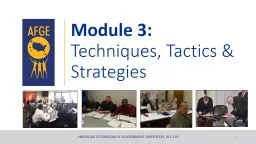

AMERICAN FEDERATION OF GOVERNMENT EMPLOYEES AFLCIO 1 Techniques Tactics amp Strategies Stasis Theory 2 Stasis Theory History and Background Developed in Ancient Greece and Rome Four core elements ID: 910293
Download Presentation The PPT/PDF document "Module 3: Techniques, Tactics & Stra..." is the property of its rightful owner. Permission is granted to download and print the materials on this web site for personal, non-commercial use only, and to display it on your personal computer provided you do not modify the materials and that you retain all copyright notices contained in the materials. By downloading content from our website, you accept the terms of this agreement.
Slide1
Module 3:Techniques, Tactics & Strategies
AMERICAN FEDERATION OF GOVERNMENT EMPLOYEES, AFL-CIO
1
Slide2Techniques, Tactics & StrategiesStasis Theory
2
Slide3Stasis Theory: History and BackgroundDeveloped in Ancient Greece and RomeFour core elements:Facts: what happened
Definition: meaning or nature of the issueQuality: seriousness of the issue
Policy: plan of actionWhere exactly do we disagree?
Goal is to avoid people talking past one another
3
Slide4Stasis Theory: FactsDid something happen?What are the facts?Is there a problem/issue?
How did it begin/what are its causes?What changed to create the problem/issue?Can it be changed?
Where did we obtain our data, are the sources reliable?How do we know the sources are reliable?
4
Slide5Stasis Theory: DefinitionWhat is the nature of the problem/issue?What exactly is the problem/issue?What kind of problem/issue is it?
Is it part of a broader class of things or events?What are its parts and how are they related?Who/what is influencing our definition of the problem/issue?
5
Slide6Stasis Theory: QualityIs the issue a good thing or a bad thing?How serious is the problem/issue?Whom might it affect (stakeholders)?
What happens if we do nothing?What are the costs of solving the problem/issue?Who or what is influencing our determination on how serious the issue is?
6
Slide7Stasis Theory: PolicyShould action be taken?Who should be involved in helping solve the problem/address the issue?What should be done about the problem?
What needs to happen to solve this problem/address this issue?Who/what is influencing our determination of what to do about this problem/issue?How/why are these sources influencing our decision?
7
Slide8Stasis Theory: ExampleTina’s grievance:Fact: Tina has been late three times this week. Union and Agency agree – stasis.
Definition: Late arrival is a violation of the personnel policy. Union and Agency agree – stasis.
8
Slide9Stasis Theory: ExampleTina’s grievance:Quality: Tina has made up the time she arrived late by staying after hours.
Union – the issue is less serious than someone who is late without making up the time. Agency – late arrival is a serious issue and making up the time is not allowed. = Core area of disagreement.
Policy: What discipline will Tina be given? Union and Agency agree that the policy book states that discipline for tardiness should be reasonable based on the seriousness of the offense
= stasis.
9
Slide10STASIS THEORY & NEGOTIATIONS
How could the bargaining process be improved by applying
stasis theory
?
10